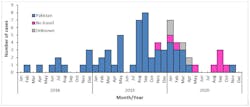CDC alerts extensively drug-resistant Salmonella Typhi infections are among U.S. residents
The Centers for Disease Control and Prevention (CDC) is providing information on extensively drug-resistant (XDR) Salmonella Typhi (Typhi) infections among United States residents, without international travel and treatment recommendations for XDR Typhi infection, reported the agency in an emergency preparedness and response health alert.
Typhoid fever is a systemic illness caused by the bacterium Salmonella enterica serotype Typhi (Typhi). Most people in the U.S. diagnosed with typhoid fever acquired it during international travel, but some acquired it in the U.S. The disease is treated with antibiotics; without appropriate antibiotic treatment, 12 to 30 percent of people with typhoid fever will die.
Typhi is transmitted through contaminated food and water and person-to-person contact. CDC recommends vaccination for people traveling to places where typhoid fever is common. Because typhoid fever vaccines are not 100 percent effective, travelers should always practice safe eating and drinking habits to help prevent infection.
In 2016, a large outbreak of extensively drug-resistant (XDR) Typhi infections began in Sindh province, Pakistan. XDR Typhi strains are resistant to antibiotics generally recommended to treat typhoid fever, including ampicillin, ceftriaxone, chloramphenicol, ciprofloxacin, and trimethoprim-sulfamethoxazole. Isolates from patients linked to the outbreak in Pakistan are susceptible to carbapenems and azithromycin. Infections among travelers to or from Pakistan have been reported globally, including in the United States.
As of Jan. 14, 2021, CDC has received 71 reports of XDR Typhi infection in the U.S., with specimens obtained from February 9, 2018, through November 16, 2020. Among 67 patients with known travel history, 58 (87percent) had traveled to Pakistan in the 30 days before illness began.
Nine (13 percent) patients from six states (NY, CA, IL, MD, NJ, and TX) reported that they had not traveled to Pakistan or any other country. Specimens from these nine patients were obtained from Nov. 7, 2019 through Oct. 7, 2020, with eight obtained in 2020. Susceptibility testing of these specimens showed the same resistance pattern described in Pakistan. CDC has not identified linkages among these patients or a common source of infection.
Case reporting of U.S. Typhi infections for 2020 is not yet complete. To date, 17 states have reported Typhi cases for 2020 compared with 39 states for 2019. Among 11 patients without international travel in 2020, eight patients were infected with XDR Typhi, one patient was infected with non-XDR Typhi, and susceptibility testing is pending for two others.
Before the outbreak in Pakistan, no case of ceftriaxone-resistant Typhi infection had been identified in the U.S. An unrelated cluster of ceftriaxone-resistant Typhi infections linked to Iraq has been reported in the United States and the United Kingdom.
Clinicians should consider empiric treatment with a carbapenem, azithromycin, or both agents for suspected typhoid fever in patients who did not travel out of the United States and for those who traveled to Pakistan or Iraq. Ceftriaxone remains an appropriate empiric treatment option for patients who traveled to countries other than Pakistan and Iraq. Clinicians should adjust treatment based on results of susceptibility testing.
This investigation is ongoing.
CDC provides:
· Recommendations for Clinicians
· Recommendations for Health Departments
· Recommendations for Public Health Laboratories
